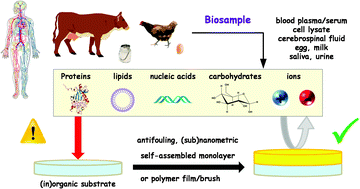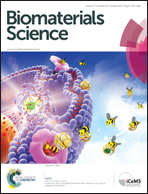A survey of state-of-the-art surface chemistries to minimize fouling from human and animal biofluids
Abstract
Upon contact with bodily fluids, synthetic materials spontaneously acquire a layer of various species (most notably proteins) on their surface. The concern with respect to biomedical equipment, implants or devices resides in the possibility for biological processes with potentially harmful effects to ensue. In biosensor technology, the issue with this natural fouling phenomenon is that of non-specific adsorption to sensing platforms, which generates an often overwhelming interference signal that prevents the detection, not to mention the quantification, of target analytes present at considerably lower concentration. To alleviate this ubiquitous, recurrent problem – this genuine biotechnological plague – considerable research efforts have been devoted over the last few decades to engineer antifouling coatings. Extensive literature now exists that describes stealth organic adlayers capable of reducing fouling surface coverage Γ down to a few ng cm−2 – however from biotechnologically irrelevant buffered solutions free or nearly depleted of any potentially interfering species. Regrettably indeed, few coatings are known to display/retain such level of performance when exposed to otherwise more complex, real-life biosamples (even diluted). Herein, we comprehensively review the state-of-the-art surface chemistries developed to date (January 2015) to minimize fouling from 8 such uncomparatively more challenging biological media (blood plasma, blood serum, cell lysate, cerebrospinal fluid, egg, milk, saliva, and urine) – whether of human or animal origin. Literature search for another 25 biological milieux generated no (exploitable) hit. Also discussed in this Review are the identification of the species responsible for fouling, and the dependence of antifouling properties on biosample source variability.


 Please wait while we load your content...
Please wait while we load your content...